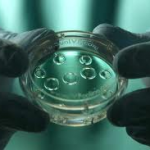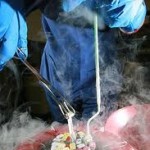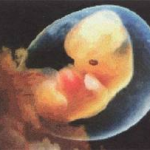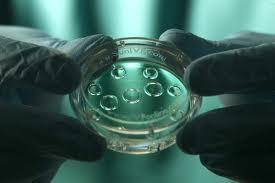Any excess healthy embryos from the in vitro fertilization (IVF) process can be frozen, in case more than one treatment cycle is needed. Freezing embryos, also known as cryopreservation, takes place for some 60% of all patients having IVF treatment. Cryopreservation of embryos is the process of preserving an embryo at sub-zero temperatures, generally at an embryogenesis stage corresponding to pre-implantation, that is, from fertilisation to the blastocyst stage.
 Embryos can be frozen from Day 2 (four cell stage) to Day 5 (Blastocyst). They are placed in thin plastic straws, sealed at both ends, and labelled with your name and identification number. They then go into a freezing machine, where the temperature rapidly drops to -150° Celsius. The straws are then placed in goblets, and put into tanks filled with liquid nitrogen, which keeps the temperature at -196° Celsius.
Embryos can be frozen from Day 2 (four cell stage) to Day 5 (Blastocyst). They are placed in thin plastic straws, sealed at both ends, and labelled with your name and identification number. They then go into a freezing machine, where the temperature rapidly drops to -150° Celsius. The straws are then placed in goblets, and put into tanks filled with liquid nitrogen, which keeps the temperature at -196° Celsius.
Indications
Embryo cryopreservation is useful for leftover embryos after a cycle of in vitro fertilisation, as patients who fail to conceive may become pregnant using such embryos without having to go through a full IVF cycle. Or, if pregnancy occurred, they could return later for another pregnancy. Spare oocytes or embryos resulting from fertility treatments may be used for oocyte donation or embryo donation to another woman or couple, and embryos may be created, frozen and stored specifically for transfer and donation by using donor eggs and sperm.
Prevalence
World usage data is hard to come by but it was reported in a study of 23 countries that almost 42,000 frozen human embryo transfers were performed during 2001 in Europe.
Pregnancy outcome and determinants
 The outcome from using cryopreserved embryos has uniformly been positive with no increase in birth defects or development abnormalities, also between fresh versus frozen eggs used for intracytoplasmic sperm injection (ICSI). Children born from vitrified blastocysts have significantly higher birthweight than those born from non-frozen blastocysts. For early cleavage embryos, frozen ones appear to have at least as good obstetric outcome, measured as preterm birth and low birthweight for children born after cryopreservation as compared with children born after fresh cycles.
The outcome from using cryopreserved embryos has uniformly been positive with no increase in birth defects or development abnormalities, also between fresh versus frozen eggs used for intracytoplasmic sperm injection (ICSI). Children born from vitrified blastocysts have significantly higher birthweight than those born from non-frozen blastocysts. For early cleavage embryos, frozen ones appear to have at least as good obstetric outcome, measured as preterm birth and low birthweight for children born after cryopreservation as compared with children born after fresh cycles.
“The worst part of IVF for a couple is going through a fresh treatment with all the drugs, injections, costs and risk this entails,†said Tim Child, a fertility specialist at the clinic. “By looking at the success rate per egg collection, including the use of all spare frozen embryos created, we can clearly demonstrate the significant benefits for couples and clinics on focusing on running a good freezing program.â€
Freezing can reduce expenses tremendously. Although it costs about $870 to freeze embryos and about $1,020 each time to use them, this compares with roughly $5,800 for an IVF cycle – and there’s no wastage of embryos. “By careful selection of spare embryos for freezing and later use,†Child said, “we are able to maximize the chances of success for a couple per expensive and potentially risky fresh IVF egg collection cycle.†Oocyte age, survival proportion, and number of transferred embryos are predictors of pregnancy outcome.
Pregnancies have been reported from embryos stored for 16 years. A study of more than 11,000 cryopreserved human embryos showed no significant effect of storage time on post-thaw survival for IVF or oocyte donation cycles, or for embryos frozen at the pronuclear or cleavage stages. In addition, the duration of storage had no significant effect on clinical pregnancy, miscarriage, implantation, or live birth rate, whether from IVF or oocyte donation cycles.
Legislation
 From October 1, 2009 human embryos are allowed to be stored for 10 years in the UK, according to the Human Fertilisation and Embryology Act 2008.
From October 1, 2009 human embryos are allowed to be stored for 10 years in the UK, according to the Human Fertilisation and Embryology Act 2008.
History
The first ever pregnancy derived from a frozen human embryo was reported by Alan Trounson & Linda Mohr in 1983 (although the fetus aborted spontaneously at about 20 weeks of gestation); the first term pregnancies derived from frozen human frozen freezing process was born in 1984. Since then and up to 2008 it is estimated that between 350,000 and half a million IVF babies have been born from embryos frozen at a controlled rate and then stored in liquid nitrogen; additionally a few hundred births have been born from vitrified oocytes but firm figures are hard to come by. It may be noted that Subash Mukhopadyay from Kolkata, India reported the successful cryopreservation of an eight cell embryo, storing it for 53 days, thawing and replacing it into the mother’s womb, resulting in a successful and live birth as early as 1978- a full five years before Trounson and Mohr had done so. A small publication of Mukherjee in 1978 clearly shows that Mukherjee was on the right line of thinking much before anyone else had demonstrated the successful outcome of a pregnancy following the transfer of an 8-cell frozen-thawed embryo into human subjects transferring 8-cell cryopreserved embryos.â€
